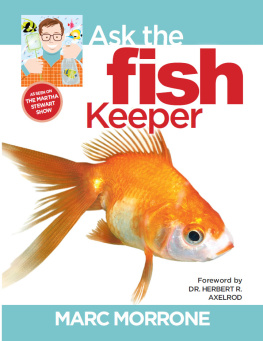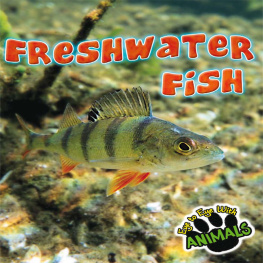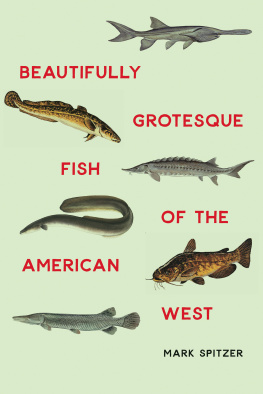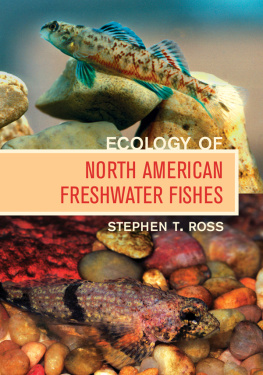Freshwater Fishes of North America
Freshwater Fishes of North America
VOLUME 1
Petromyzontidae to Catostomidae
Edited by Melvin L. Warren, Jr.,
and Brooks M. Burr
Illustrated by Joseph R. Tomelleri

2014 Johns Hopkins University Press
Color illustrations 2014 Joseph R. Tomelleri
All rights reserved. Published 2014
Printed in China on acid-free paper
9 8 7 6 5 4 3 2 1
Johns Hopkins University Press
2715 North Charles Street
Baltimore, Maryland 21218-4363
www.press.jhu.edu
Library of Congress Cataloging-in-Publication Data
Freshwater fishes of North America / edited by Melvin L. Warren, Jr., and Brooks M. Burr ; illustrated by Joseph R. Tomelleri.
volumes cm
Includes bibliographical references and index.
ISBN-13: 978-1-4214-1201-6 (hardcover : alk. paper)
ISBN-13: 978-1-4214-1202-3 (electronic)
ISBN-10: 1-4214-1201-2 (hardcover : alk. paper)
ISBN-10: 1-4214-1202-0 (electronic)
1. Freshwater fishesNorth America. I. Warren, Melvin L., Jr., editor of compilation.
II. Burr, Brooks M., editor of compilation.
QL625.F74 2014
597.176dc23 2013015264
A catalog record for this book is available from the British Library.
Special discounts are available for bulk purchases of this book. For more information, please
contact Special Sales at 410-516-6936 or specialsales@press.jhu.edu.
Johns Hopkins University Press uses environmentally friendly book materials, including
recycled text paper that is composed of at least 30 percent post-consumer waste, whenever
possible.
Contents
, by Melvin L. Warren, Jr., and Brooks M. Burr
Stephen T. Ross and William J. Matthews
Deborah A. McLennan
Ian C. Potter, Howard S. Gill, and Claude B. Renaud
Michael D. Burns, Carter R. Gilbert, and Melvin L. Warren, Jr.
Bernard R. Kuhajda
Bernard R. Kuhajda
Anthony A. Echelle and Lance Grande
Brooks M. Burr and Micah G. Bennett
Eric J. Hilton, William E. Bemis, and Lance Grande
Alex Haro
Lisa J. Hopman and Carter R. Gilbert
Nicholas J. Gidmark and Andrew M. Simons
Phillip M. Harris, Gregory Hubbard, and Michael Sandel
Contributors
William E. Bemis
Cornell University
Micah G. Bennett
Southern Illinois University
Michael D. Burns
University of Hawaii at Manoa
Brooks M. Burr
Southern Illinois University
Anthony A. Echelle
Oklahoma State University
Nicholas J. Gidmark
Brown University
Carter R. Gilbert
Florida Museum of Natural History
Howard S. Gill
Murdoch University
Lance Grande
The Field Museum of Natural History
Alex Haro
United States Geological Survey
Phillip M. Harris
The University of Alabama
Eric J. Hilton
Virginia Institute of Marine Science
Lisa J. Hopman
Southern Illinois University
Gregory Hubbard
The University of Alabama
Bernard R. Kuhajda
The University of Alabama
William J. Matthews
University of Oklahoma
Deborah A. McLennan
University of Toronto
Ian C. Potter
Murdoch University
Claude B. Renaud
Canadian Museum of Nature
Stephen T. Ross
University of New Mexico
Michael Sandel
The University of Alabama
Andrew M. Simons
University of Minnesota
Melvin L. Warren, Jr.
USDA Forest Service
Preface
The North American freshwater fish fauna comprises a little more than 1,200 native species in 50 families. It is the most thoroughly studied and largest temperate fish fauna (Page & Burr 2011) in the world. In comparison, an analysis and compendium of European freshwater fishes included 546 native species in about 24 families (Kottelat & Freyhof 2007); Europe is about one-third the land area of North America. Australia has nearly 300 freshwater fishes in 35 families (Allen 1989; Allen et al. 2002) in a land area about that of the United States (minus Alaska). This number includes many marine species that enter fresh water, and highly unusual freshwater fish lineages occur there (e.g., Salamanderfish, Lepidogalaxias salamandroides; Australian Lungfish, Neoceratodus forsteri; Nursery-fish, Kurtus gulliveri). The only other temperate fish fauna that could rival North America is Asian, but reliable information on this vast area and its fishes remains poorly understood by scientists in the New World. An estimate for the country of China stands at 1,010 native species (M. Kottelat pers. comm.). Unsurprisingly, as for many plant and animal groups, the tropical regions of the world harbor freshwater fish faunas several times larger than those of temperate regions (Lundberg et al. 2000; Berra 2007).
In the mid-1970s knowledge of North American freshwater fishes was confined to a few specialists, but even so for many species (and families) little was available on natural history or ecology. In 1980, a landmark volume was published that used spot distribution maps to illustrate the ranges of all freshwater fish species in the United States and Canada (Lee et al. 1980 et seq.). That volume made available to the lay public as well as specialists a level of knowledge of the North American freshwater fish fauna theretofore unknown. Shortly thereafter a physician from Forsythe, Missouri, combined his hobby of scuba diving and snorkeling with photography and revealed, even to specialists, the incredible colors of the North American native fish fauna, especially in their brightest breeding condition, as well as some of their unique and fascinating natural histories. William N. Roston eventually traveled the continent looking for clear water and fish to photograph in their natural environment (never in aquaria). A number of his photographs are used here.
During this period, numerous books focused on fish faunas of individual states (e.g., Alabama, Arkansas, California, Illinois, Kansas, Mississippi, Missouri, New Mexico, Ohio, Virginia, West Virginia, Tennessee, Washington, Wisconsin) as well as Canada, making even more detail on fishes available to the public. These works allowed for the first complete identification guide to all freshwater fishes in the United States and Canada (Page & Burr 1991, revised 2011). Nevertheless, it was not until the Freshwater Fishes of Mexico (Miller et al. 2005) was published that it was possible for us to consider editing this three-volume work on the natural history, ecology, and conservation of North American freshwater fishes. We are indebted to a large community of ichthyologists, fisheries biologists, and other workers in related fields (e.g., physiology, genetics, behavior, ecology) who have investigated the details of the lives of fishes in such a way that much technical information can now be synthesized in one place and again made available to the public and other specialists.
Even though our overarching goal was to synthesize as much information as possible on North American freshwater fishes, the job of gathering information is far from complete. In editing this work and writing synthesis chapters of our own, we were struck at once by the incredible natural history and taxonomic diversity among our native freshwater fishes but also by the large and critical information gaps that remain. Unfortunately, for many species (and nearly entire families), the syntheses presented here are (or are close to being) obituaries. For many species and groups, the biological information needed to help recover them, to slow population declines, or to prevent extinction is simply unavailable. That said, the most critical component of conserving North American freshwater fishes is the prevention of habitat loss and degradation by humans, not lack of biological information. Fishes in this fauna have an incredible tenacity for life, whether we completely understand their biology or not, but we as co-inhabitants of the North American continent need to provide them the opportunity to endure. We hope that this work helps stem the high rates of population decline and extinction being experienced across the North American fish fauna. We also hope this work stimulates a whole new generation of ichthyologists and fisheries researchers to further expand our knowledge and appreciation of the natural history, ecology, and conservation of the great freshwater fish fauna of North America.
Next page







